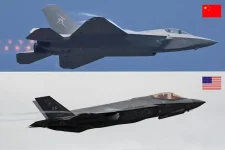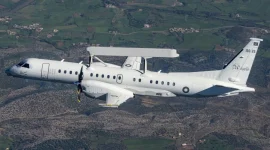- Views: 5K
- Replies: 19
In modern military conflicts, achieving superiority in information and situational awareness often dictates the outcome. Defence analysts suggest that for the Indian Air Force (IAF) to secure a decisive advantage in any potential future confrontation with Pakistan, its strategy must evolve beyond reactive measures.
A key proposal involves proactively targeting Pakistan Air Force (PAF) assets crucial for its operational awareness, particularly the Saab 2000 Erieye Airborne Early Warning and Control System (AWACS).
These AWACS aircraft function as vital command centres in the sky. Equipped with powerful radar systems like the Swedish-origin Erieye, these planes provide the PAF with extended surveillance capabilities, enabling them to detect IAF aircraft or missile movements far beyond their border radars and coordinate defensive actions effectively. They are widely considered force multipliers, acting as the operational 'eyes and ears' for the PAF's air defence network.
According to strategic experts, disabling these airborne surveillance platforms, especially during the initial phase of hostilities, would significantly impair Pakistan's capacity to organise an effective air defence or manage its fighter aircraft operations. Without the overarching view provided by AWACS, the PAF would be largely reliant on ground-based radar systems, which have limitations in range, mobility, and survivability, particularly in challenging terrains.
India's recent acquisition of advanced long-range surface-to-air missile (LRSAM) systems provides new strategic options. The Russian-made S-400 Triumf, with a reported engagement range of up to 400 kilometres, and the Indo-Israeli developed Barak-8ER (Extended Range), capable of hitting targets significantly beyond 150 kilometres, give India the ability to engage high-value aerial targets deep within Pakistani airspace without deploying its own aircraft across the border. This capability allows for striking critical assets while managing escalation risks.
Utilising these ground-based missile systems to target essential PAF aerial assets like the AWACS, or potentially air-to-air refuellers and electronic intelligence aircraft, could offer several advantages for India during periods of high tension:
- Disrupting PAF Command: Eliminating airborne radar coverage would severely hinder the PAF's ability to manage air battles effectively.
- Facilitating IAF Operations: Reduced early warning for the PAF would allow IAF strike formations, potentially employing stand-off or hypersonic weapons, to penetrate deeper into enemy territory with a lower risk of being intercepted.
- Shifting the Strategic Balance: Such a preemptive move could force the PAF into a defensive posture, compelling it to withdraw valuable air assets and divert focus from offensive planning to protecting its airspace.
Furthermore, employing surface-launched missiles rather than manned fighter jets for such a mission could initially offer a degree of strategic ambiguity, potentially providing India with plausible deniability in the immediate aftermath.
The analysis concludes that the IAF should consider adopting a more proactive approach focused on shaping the battlefield early. Targeting the adversary's primary surveillance and control assets like AWACS is presented not merely as a destructive act, but as a strategic move to disable the opponent's ability to observe, orient, decide, and act effectively in network-centric warfare scenarios.




